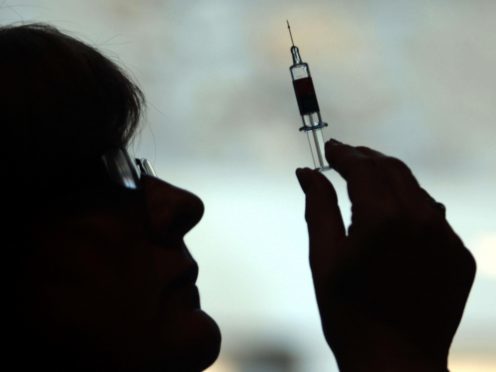A declining number of children in England are being vaccinated against potentially deadly diseases, new figures show.
Data from NHS Digital shows that vaccination coverage declined last year for a number of immunisations which protect youngsters from a horde of different illnesses, from meningitis to measles.
Coverage for the measles, mumps and rubella (MMR) vaccine for children reaching their second birthday fell to 91.2% – the fourth consecutive year that MMR coverage has decreased.
It is also the lowest rate recorded since 2011/12.
The World Health Organisation (WHO) recommends that coverage is at least 95%.
But England-wide MMR coverage for children reaching their fifth birthday fell from 95% in 2016/17 to 94.9% in 2017/18.
Figures published today show that coverage for 9 of the 12 routine #vaccinations measured at age 12 months, 24 months or five years declined in 2017-18, in #England compared to the previous year. Read the full report to find out more.https://t.co/JVEpAqU3Mh
— NHS Digital (@NHSDigital) September 18, 2018
The WHO declared that the UK had “eliminated” measles last year – which is achieved once a country has sustained “interruption of endemic transmission” for at least 36 months.
But so far this year there have been hundreds of cases of measles – figures from Public Health England show that between January 1 2018 and September 10 2018 there have been 876 laboratory confirmed measles cases in England.
The increase in measles has been linked to travel and outbreaks in Europe.
Officials have warned that young people and adults aged 15 and over who missed out on MMR vaccine when they were younger and some under-vaccinated communities have been particularly affected.
Uptake of the MMR vaccine fell heavily in the late 1990s following the publication of research by Andrew Wakefield which suggested a possible link between the inoculation and autism.
Coverage levels dipped to a low of 80% in 2003.
Experts have widely discredited his study and he was struck off the medical register in 2010.
MMR is a safe and effective combined vaccine that protects against 3 separate illnesses – measles, mumps and rubella (German measles) – in a single injection. Speak to your GP if you're not sure whether you're up to date with your vaccination https://t.co/YLbkV5gaSo pic.twitter.com/2eLwJNOojO
— NHS Mid Essex CCG (@MidEssexCCG) September 14, 2018
Commenting on the latest figures, leading nurses warned that Britain is “turning back the clock and leaving thousands of children unprotected”.
Meanwhile the new data shows that the percentage of two-year-olds who had received the Hib and MenC vaccine, which protects against meningitis caused by meningococcal group C bacteria and haemophilus influenzae type b, also declined between 2016/17 and 2017/18 to 91.2%.
And the percentage of one-year-olds who had received the so called five-in-one vaccine – a single injection which protects against diphtheria, tetanus, whooping cough, polio Hib (Haemophilus influenzae type b) – declined for the fifth year in a row, reaching its lowest level since 2008/09.
In 2017/18, 93.1% of one-year-olds had been vaccinated, according to the NHS Digital report, Childhood Vaccination Coverage Statistics.
But the number who had received the jab by the age of two was above the target of 95%.
Children are now offered the six-in-one vaccine which also protects against hepatitis B.
Uptake of the vaccines which protect against pneumococcal disease also fell between 2016/17 and 2017/18.
The rotavirus vaccine was the only one that had an increase in coverage, from 89.6% 2016/17 to 90.1% in 2017/18.
Commenting on the analysis, Helen Donovan, professional lead for public health at the Royal College of Nursing, said: “For the first time last year, Britain was declared free of endemic measles, but these figures show we are turning the clock back and leaving thousands of children unprotected.
“Coverage declined in nine out of 12 of the routine vaccination measures compared to last year.
“This means immunity against deadly or life-changing diseases such as tetanus, diphtheria and polio is dropping. These were diseases of the past – they should not be part of our future.”
Dr Michael Edelstein, consultant epidemiologist at Public Health England, said: “We are seeing small reductions in uptake for most of the childhood vaccines which is why we continue to encourage all parents to get the best protection for their children by ensuring they are fully immunised.
“We are working closely with the NHS, and with staff in general practice where most vaccinations are delivered, to improve uptake.”
Information on the childhood vaccination schedule – including which immunisations youngsters should be receiving at different ages – can be found at: www.nhs.uk/conditions/vaccinations/childhood-vaccines-timeline/
